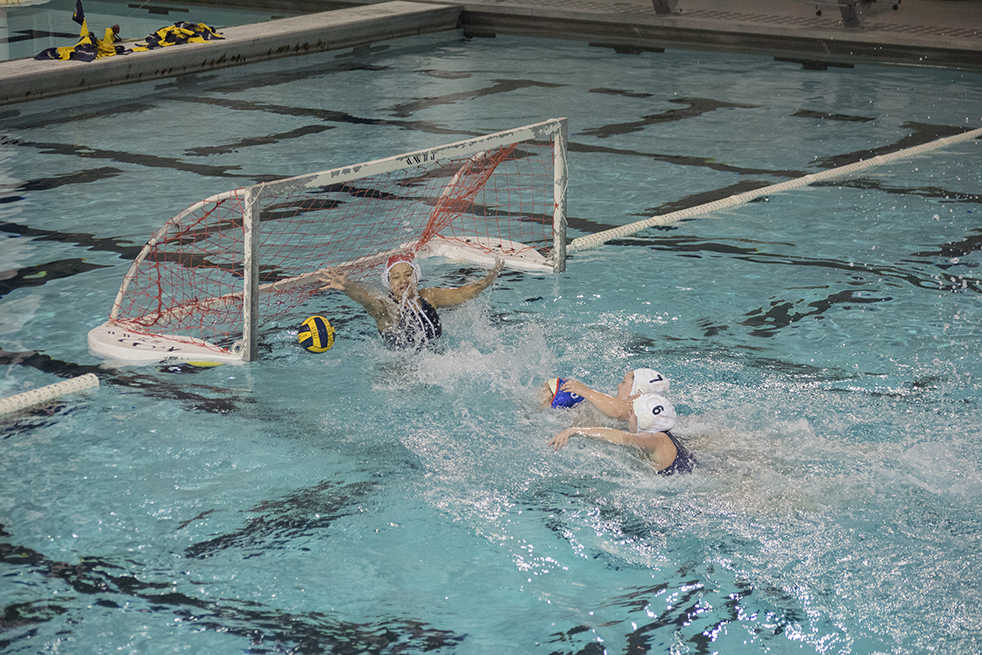One of Tech’s youngest club sports is already taking root — despite not existing before 2016, the Women’s Water Polo club is on the rise and making a name for themselves. “This was the first year that we’ve been recognized by the [Collegiate Water Polo Association] and gone to official tournaments … as a women’s team, so we’ve grown quite a bit!” says Rachel Cooper, a fourth year who’s been with the team since the beginning.
For years prior, water-polo had been a co-ed affair — women who wanted to play water polo had to join in with the mens team and play with them instead. “But spring 2016 was when the womens team got chartered — we got enough women on the team that the older girls on the team decided, ‘Let’s try to do our own thing’” — and hence, the women’s water polo team was born.
Water polo, for the unacquainted, is like soccer — there are goals and a goalie on each team, and teams score points by getting the ball into their opponent’s goal. Unlike soccer, however, the game is usually played in a pool, and players pass and score using their hands and not their feet. It’s quite the physical and rough and tumble sport, Cooper describes: “Anything that the ref can’t see goes … if you’re defending someone, you’ll keep your hand on them at all times. There are a lot fouls called — it’s like hockey, where you can get kicked out of the pool for a period of time. It’s a pretty physical sport.”
Usually, a game of water polo consists of four quarters, each eight minutes long, and the team with the most goals at the end of the match wins. Players can only use one hand to pass, defend and block, except for goalies who can use both hands. The goalies try to defend small nets, which either float in the pool or are attached to the side of the pool.
Players tend to set up in different offensive and defensive configurations. The most popular configuration is known as the “3-3”: a team lines up in two parallel lines facing the opponent’s goal — three players for each line. But if a player must leave the pool on a penalty in a 5 vs. 6 situation, the team losing the player tends to collapse into a line surrounding their goal, serving as a wall to keep their opponents from scoring until the penalized player can return.
On defense, teams work to regain possession by knocking the ball away from the offense, and staying between the goal and the ball handler at all times, a task requiring relentless effort.
As a result, water polo players need to be in good shape. “A lot of people that come in are ex-swimmers from high school,” explains Cooper. “For practice, we start out with a swim set, a half-hour to forty-five-minutes of straight swimming laps … then we’ll go into leg specific conditioning to get treading up.” Treading water efficiently is one of the more important skills in water polo — athletes need to keep afloat while tussling with opponents, and it’s easy to tire out trying to keep your head above water while playing.
The young women’s water polo team has spent a good amount of time finding their sea legs. Before being recognized by the CWPA, the team went to rec tournament after rec tournament, but now they get to play with elite competitors. Despite being new to the scene, the team is taking big steps forward to be competitive. “Our first tournament of this semester, we went to a rec tournament at NC State, and we came away with a 3-1 record — the first time we had a winning record as a women’s team in a tournament! That was when we were like, ‘Hey — we can actually do this!’”
But it is an uphill battle for the team when it comes to recruiting — in addition to all of the additional challenges of being a new organization, the team faces a substantial obstacle in recruiting thanks to the lack of prevalence of the sport at the high school level. As a result, there’s a lack of visibility and a lack of experience in the sport for students coming in. But it’s fine if students come in having never played before, says Cooper. “A lot of people are ex-swimmers … if you were a swimmer in high school, that’s good experience. And then the rest, we can teach, as long as you can stay afloat!”
It’s not all competition all the time for the team, however — Cooper speaks glowingly of the team as a tight-knit and supportive community. “We want to be competitive, but we also want the team to benefit your physical health and your mental health.” For Cooper, playing water polo serves as a major source of stress relief — for dealing with the trials and tribulations of Tech, water polo can be a great outlet to let off some steam and get a good workout in the process.
For many, water polo is a lifelong affair — for good reason, says Cooper. Sports like baseball and football have very limited utility after graduation, unless a student-athlete turns professional; the former sport requires large parks, expensive equipment and skilled opponents. The latter is dangerous and sees athletes decline dramatically as they exit their physical primes in their early thirties.
Water polo offers something that neither sports possibly can: the hope of lifelong enjoyment, at Tech and, in many cases, far beyond.
“Even once [club members] graduate, there are masters teams that play water polo; there’s one that plays at Georgia Tech! So you can keep it going beyond just a college thing. There are guys in their forties and fifties who are competitive — they beat me up in the pool!”
